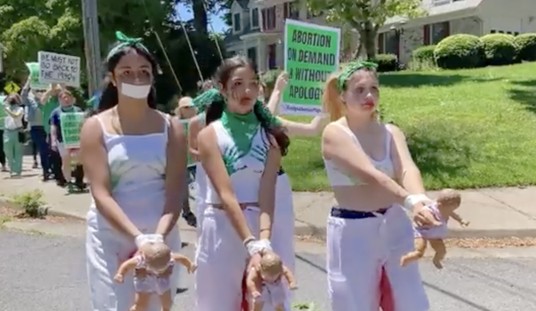Ed Driscoll and I had fun last week with my brainwave about the preposterously-named Adam Smith’s freakish drive-by harassment of a (preternaturally Zen) Chick-Fil-A employee.
I was struck by the incident’s similarity to the famous “diner” scene in Five Easy Pieces (1970), right down to the “chicken”:
Ed quoted a film critic who held up that scene “as the point where American movies began to celebrate gratuitous anger.”
Anyone who’s watched other drivers careen out of the parking lot after the latest Fast & Furious movie has to admit that films affect our behavior; that cinematic ideas and attitudes trickle into the cultural water table, and sometimes pollute it.
To take one trivial instance: I’ve written before about the influence all those 1970s “Satanic children” flicks had on my decision not to have kids.
Three other movie tropes from that era impacted audiences in ways that continue today.
(Language and content warning:)
#3 — Stupid evil Southerners (and Texans)
According to Hollywood, a low level “Civil War” remains underway: backward, inbred rednecks below the Mason-Dixon line regularly torture and murder hapless Northern tourists who foolishly wander into their run down gas station/motel/wax museum/hunting grounds.
Deliverance (1972) and The Texas Chainsaw Massacre (1974) mainstreamed this cliché — a.k.a. “Paddle faster — I hear banjos!” — in the 1970s, but they were predated by two semi-obscure movies by cult directors who influenced other filmmakers who came up later.
Two Thousand Maniacs! (1964) by “Godfather of Gore” Herschell Gordon Lewis is essentially a grand guignol version of Brigadoon, in which Yankee tourists are lured to a Southern town’s centennial celebration, then forced to “participate in various sick games which lead to their gory deaths,” as revenge for the Union Army sacking of the town a hundred years earlier.
However, I agree with the folks at HorrorMovieADay that The Sadist, released the year before, is probably the first “folks break down en route to something and run afoul of a psychotic killer” film.
This ultra-low budget flick remains suspenseful and shocking almost fifty years after it was made (probably because everything happens in real time – and the actors were firing live ammo during some scenes!).
http://www.youtube.com/watch?v=MeDyDQUmKUI
The two villains are clearly based on real life spree-killer Charles Starkweather and his girlfriend, who also inspired Badlands (1973) and Natural Born Killers (1994).
The difference between those former portrayals and the latter is instructive.
In these earlier films, the criminal couples are unattractive, dimwitted, sick losers cultivating delusions of grandeur that would be laughable if they didn’t come with a body count. (Just listen to Sissy Spacek’s cloying, overwrought, mock-heroic diary entries in Badlands.)
Conversely, not a few real life murderers have proudly cited Oliver Stone’s fatally cool Mickey and Malorie as their inspiration.
The “hicksploitation” genre has proven depressingly enduring, from The Hills Have Eyes (1977) and House of 1000 Corpses (2003) to the well-observed parody that turns the cliché inside out, Tucker & Dale vs Evil.
The demonization of Americans from the South is one of the last socially acceptable prejudices, as well as one of the most stubborn and mindless.
Liberals who pretend to bemoan America’s “blue” and “red” split and the “divisiveness” it represents are the same ones who keep this cliché alive, for their own smug amusement and, in some cases, financial profit.
Not exactly a recipe for national unity.
http://www.youtube.com/watch?v=vQOZHEYhVtU
#2 — Crazy American soldiers
The Greatest Generation gave us a lot of things — including, believe it or not, the motorcycle gang.
The first outlaw “one-percenters” were returning vets reluctant or unable to return to “boring” civilian life (and who were no doubt self-medicating their cases of what we now call PTSD.)
(I’ll leave it to shrinks to theorize why is was that when the Greatest Generation’s children took over Hollywood in the “easy riders, raging bulls” 1970s, those Boomers churned out “outlaw biker” flicks ad nauseum…)
Veterans who didn’t take their disaffection that far were sympathetically portrayed in the candid moving classic The Best Years of Our Lives (1946), about men struggling to re-acclimate to home and family.
Occasionally, this post-war disillusionment was only hinted at, providing the subtext of the vast majority of films noir — and even lighter fair on occasion. We forget that the original Ocean’s 11 (1960) crew served together in the 82nd Airborne; their battle-hardened skills and cynicism are integral to their caper.
The same cynicism informs Frank Sinatra’s vet-turned-presidential assassin in Suddenly, and needless to say, he and his crewmen in The Manchurian Candidate aren’t mental health poster children, either (thanks to Communist Korean brainwashing, of course.)
But — and this is a weird “but” — the crazy vet characters in those two films “only” want to kill the President. Things get scarier when American soldiers stateside start aiming at total strangers.
Hollywood started mashing up reality in its usual selective fashion. Soldiers, especially Marines, were perceived as villains, thanks to the shocking crimes of a few real life killers.
Undeniable, inconvenient little “details” like Lee Harvey Oswald’s traitorous communism, or Eagle Scout turned Texas tower sniper Charles Whitman’s brain tumor, would have muddled the sick narrative taking shape:
Foreign wars lead to domestic blowback, and clean cut American boys with guns are poised to snap and mow us all down.
(Never mind that neither Oswald or Whitman — two more different men of the same generation can hardly be imagined — ever experienced combat.)
After piling up movie-making experience with the low budget 1960s and 70s grindhouse biker flick mentioned above, those same directors each felt obligated to put out at least one “crazed Vietnam vet” movie. Again, the fact that Vietnam vets were no “crazier” than any other mattered little.
Hence the avalance of Oscar-winning hits we’re all familiar with: The Deer Hunter, Full Metal Jacket, Platoon, Jacob’s Ladder, Coming Home, Taxi Driver, Quentin Tarantino’s beloved Rolling Thunder — and don’t forget the less acclaimed but surprisingly enduring Rambo character, introduced in First Blood.
However, from what I can gather, the very first “crazy Vietnam vet” appeared on film back in 1965, in a movie directed by a fellow who’d seen (and photographed) action in World War II.
I have a lot of time for Russ Meyer, so I’m not thrilled about handing him this dubious distinction, for his low budget roughie, Motorpsycho.
Incredibly, the movie combines our two themes here: “Crazy Vietnam vets” AND outlaw biker culture.
Go figure.
Clips of Motorpsycho are hard to come by and frankly less than impressive. This trailer from the milestone film Targets (1968) better captures Hollywood’s attitude towards returning servicemen:
#1 — Marriage is for suckers
This one needs a thousand words of its own, at least, but here goes:
The groom might have been a tad reluctant, but as far as female characters (and audiences, and studio heads were concerned) marriage was almost always the end game in movies. 1955’s The Tender Trap is the exception that proves the rule, and even it has a happy (that is, matrimonial) ending (while nevertheless leaving a bitter aftertaste.)
If marriages failed, like in Dodsworth, the couple was to blame, not the institution.
Cynical, fatalistic post-war films noir more or less invented the now-ubiquitious “dark underbelly of the American dream” trope, with its “who can say what’s right and wrong?” subtext.
So I can’t blame Boomers for that corrosive cliche, as much as I’d like to; no matter how worthy a number of them are, how many more “suburbia is crawling with horrible secrets” movies — The Ice Storm, Donny Darko, Blue Velvet, American Beauty — can we take?
(Especially when you consider that the characters of British “kitchen sink” cinema at the time, still “living” under rationing in a rundown nation in which widespread home, appliance or car ownership — and even in parts of London, indoor plumbing — was unheard of) would have gladly traded places with their whining gilded-cage U.S. counterparts on Revolutionary Road.)
It was just a simple step from bashing suburbia to denigrating its raison d’etre, matrimony.
Just like any old fashioned romance, The Graduate (1967) concludes with a wedding — sort of.
Our hero kidnaps the woman he loves just as she’s about to marry another.
We all cheer and they’re thrilled with themselves… for about 30 seconds:
Many other 60s and 70s films begin where The Graduate ends. Marriage is a “bummer.” Domesticity is boring. Divorce isn’t the end of the world. Heck, you don’t even have to “go to Reno” to do it anymore:
It’s really tough to hand a first-place ribbon to any particular movie in this category of films, which helped normalize and sanction attitudes and behaviors that poisoned untold millions of children, never mind adults.
Scenes from a Marriage (1973) played art houses, and despite its title, 1967’s Divorce American Style doesn’t quite live up to its title.
Did any man really want to end up like the guys in The Odd Couple (1968)?
That said, Neil Simon deserves some blame for popularizing the acceptance of marriage/divorce culture of the era, as a mere glance at his credits indicates.
While it pains me to do so, I’m obliged to cite An Unmarried Woman as one of the most (unintentionally) destructive movies in this category.
My respect for Jill Clayburgh is a matter of record. Her performance in this film in particular is one for the ages. What a contrast to the simpering Tina in Diary of a Mad Housewife, released six years earlier. American women sure had “come a long way” baby in a very short time.
Her face’s metamorphosis when she’s unceremoniously dumped by her husband in the middle of a busy morning rush hour street is the precise cinematic counterpoint to Garbo’s famously frozen, enigmatic visage at the conclusion of Queen Christina, but just as memorable, as her New York Times obituary noted in 2010:
In the most famous scene in Jill Clayburgh’s most influential movie, her character reacted to the news that her husband wanted to leave her. Ms. Clayburgh’s Erica responded with such naturalness, confusion and wounded pride that she captured the imagination of a generation.
“As Miss Clayburgh plays this scene,” Vincent Canby wrote about “An Unmarried Woman” in 1978, “one has a vision of all the immutable things that can be destroyed in less than a minute, from landscapes and ships and reputations to perfect marriages.” But she proved that a reputation could be made in less than a minute too.
Clayburgh’s character and her daughter endure great suffering and confusion. Her first forays into the singles scene are excruciating. This is not a pro-divorce movie.
But…
Can anyone deny that the iconic vision of Clayburgh at the very end of the film, draped in sexy, flowing white and maneuvering her new lover’s giant canvas along (another) busy street without a single misstep, isn’t downright aspirational?
How bad can divorce be if you end up looking this amazing?














Join the conversation as a VIP Member